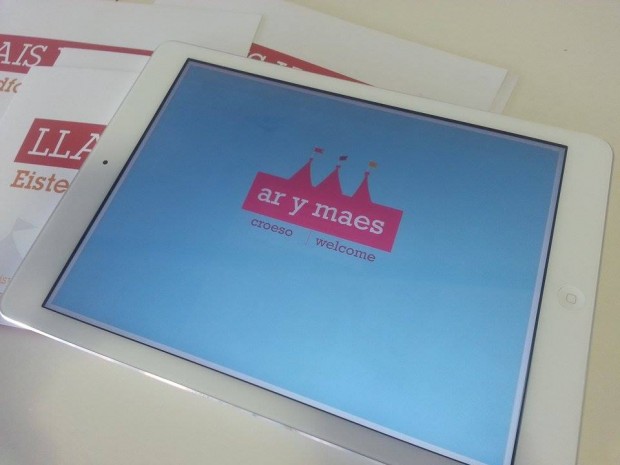The Ar Y Maes mobile app has been marketed as an important digital companion for visitors to the Eisteddfod 2014. Using around 50 beacons placed strategically around the Maes, the app uses Apple’s iBeacon technology to detect the location of the user and provide them with information about the events around them. An innovative and potentially useful idea, then – but does it work?
Provided you’re using mobile data rather than the Maes non-existent WiFi connection (that has been plagued with problems since Friday) the answer is a resounding yes. After a two-second start-up screen you’re greeted by the main interface that is both intuitive and easy to use, forcing you only to click Eisteddfod 2014 in the sidebar before you’re thrust into content according to where you are and the time of day.
As was demonstrated in conversation with Rhys Jones (the Co-founder of Locly, a content platform for beacons) Ar Y Maes offers an incredibly diverse range of content. From theatre schedules to information about exhibits that are directly in front of you, Ar Y Maes aims to bring Eisteddfod to life in a way that has never been done before. Although similar beacon networks exist around the United Kingdom (including London’s Regent Street, where shops can provide their customers with personalised information dependent on their purchasing habits) the Maes is home to what is believed to be the one of the largest beacon implementations ever.
It’s an investment that appears to be paying off; within seconds of walking towards the Science and Technology Pavilion, I’d been told what the tent had to offer and also been given the day’s schedule so I could set aside time for the Flash Bang Show! at 13.00. I can’t say I wasn’t initially sceptical about the system (you could be forgiven that it’s a pointless replacement to the traditional booklet) but after my own experience, receiving information is not only faster, but adaptable too – no longer does a schedule change result in visitor miscommunication and an empty audience.
Another standout feature of the application itself is its translation facilities. In the options menu the “content language” selection boasts accurate conversions in both Welsh and English, and this allows every visitor to enjoy the experience and ensures that nobody feels like they’ve been left by the wayside.
What’s most exciting, however, is the staggering potential. Aside from the perhaps more obvious evolutions such as notifications reminding you about when an event is just starting, Rhys Jones’ belief in the “Internet of things” opens up an infinite number of possibilities, for both visitors and exhibitors. The latter can see if visitors spend an unusually long time around a particular exhibit or if one is being completely ignored (allowing them to tweak their attractions at future events) and visitors can enjoy an increased amount of engagement with the company or exhibitor in question via special offers and messages.
It’s difficult to find the negatives. As previously alluded to, a solid internet connection is crucial and should future Eisteddfod festivals suffer the same WiFi quality as this year, the location of the Maes will have to account for the availability of fast mobile data. There are also those who will claim that applications such Ar Y Maes are developed at the expense of debatably more accessible forms of communication (not everyone has a smartphone, after all) but the responsibility for this inclusion falls at the feet of the Eisteddfod organisers rather than the Locly developers who have managed to make the Maes a more exciting and interactive place to be.



Comment on this article